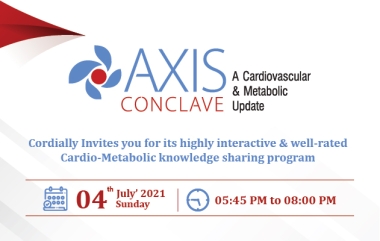test
test
test
test
test
test
test
test
test
test
Webinars
Videos
Heart Failure Peer Exchange Forum-Bangalore
Eminent Cardiologists from Bangaloreshare their practical experiences and insights on managing Heart Failure cases
Heart Failure Peer Exchange Forum-Bangalore
Eminent Cardiologists from Bangaloreshare their practical experiences and insights on managing Heart Failure cases
Heart Failure Peer Exchange Forum-Bangalore
Eminent Cardiologists from Bangaloreshare their practical experiences and insights on managing Heart Failure cases
Heart Failure Peer Exchange Forum-Vijaywada
Eminent Cardiologists from vijaywada share their practical experiences and insights on managing Heart Failure cases
Heart Failure Peer Exchange Forum-Vijaywada
Eminent Cardiologists from vijaywada share their practical experiences and insights on managing Heart Failure cases
Heart Failure Peer Exchange Forum-Vijaywada
Eminent Cardiologists from vijaywada share their practical experiences and insights on managing Heart Failure cases
Heart Failure Peer Exchange Forum-Kolkata
Eminent Cardiologists from Kolkata share their practical experiences and insights on managing Heart Failure cases
Heart Failure Peer Exchange Forum-Kolkata
Eminent Cardiologists from Kolkata share their practical experiences and insights on managing Heart Failure cases
Heart Failure Peer Exchange Forum-Kolkata
Eminent Cardiologists from Kolkata share their practical experiences and insights on managing Heart Failure cases
Courses
Medshorts

Combination of rivaroxaban and aspirin reduces ischemic risk after LER
According to a recent study, the combination of rivaroxaban with aspirin or dual antiplatelet therapy following lower extremity revascularization (LER) for peripheral artery disease effectively decreases the risk of ischemic events. The study’s findings were published in the journal, Circulation.
In the VOYAGER PAD trial, a total of 6564 patients with symptomatic peripheral artery disease were randomly assigned to two different treatment groups. The groups received 2.5 mg of rivaroxaban BID or a matching placebo and a daily dose of 100 mg aspirin. The primary efficacy outcome included acute limb ischemia, myocardial infarction, major amputation of a vascular pathogenesis, ischemic stroke, or cardiovascular death.
During the 3-year follow-up period, 4,379 patients (66.7%) received endovascular LER, while 2,185 patients (33.3%) received surgical LER. The use of rivaroxaban resulted in a 15% reduction in the risk of the primary outcome across both types of LER procedures. This translated to an absolute risk reduction of 0.92% at 6 months and 1.04% at 3 years.
For patients who underwent endovascular LER, rivaroxaban reduced the risk of acute limb ischemia or major amputation of vascular pathogenesis by 30%. The absolute risk reduction was 1.0% at 6 months and 2.0% at 3 years when compared to aspirin alone. The median duration of concomitant dual antiplatelet therapy with clopidogrel treatment among patients who underwent endovascular treatment was 31 days. Regardless of the background clopidogrel, rivaroxaban consistently provided a significant advantage.
To summarize, adding rivaroxaban to aspirin or dual antiplatelet therapy following lower extremity revascularization for peripheral artery disease decreases the risk of ischemic events.

Combination of rivaroxaban and aspirin reduces ischemic risk after LER
According to a recent study, the combination of rivaroxaban with aspirin or dual antiplatelet therapy following lower extremity revascularization (LER) for peripheral artery disease effectively decreases the risk of ischemic events. The study’s findings were published in the journal, Circulation.
In the VOYAGER PAD trial, a total of 6564 patients with symptomatic peripheral artery disease were randomly assigned to two different treatment groups. The groups received 2.5 mg of rivaroxaban BID or a matching placebo and a daily dose of 100 mg aspirin. The primary efficacy outcome included acute limb ischemia, myocardial infarction, major amputation of a vascular pathogenesis, ischemic stroke, or cardiovascular death.
During the 3-year follow-up period, 4,379 patients (66.7%) received endovascular LER, while 2,185 patients (33.3%) received surgical LER. The use of rivaroxaban resulted in a 15% reduction in the risk of the primary outcome across both types of LER procedures. This translated to an absolute risk reduction of 0.92% at 6 months and 1.04% at 3 years.
For patients who underwent endovascular LER, rivaroxaban reduced the risk of acute limb ischemia or major amputation of vascular pathogenesis by 30%. The absolute risk reduction was 1.0% at 6 months and 2.0% at 3 years when compared to aspirin alone. The median duration of concomitant dual antiplatelet therapy with clopidogrel treatment among patients who underwent endovascular treatment was 31 days. Regardless of the background clopidogrel, rivaroxaban consistently provided a significant advantage.
To summarize, adding rivaroxaban to aspirin or dual antiplatelet therapy following lower extremity revascularization for peripheral artery disease decreases the risk of ischemic events.


Combination of rivaroxaban and aspirin reduces ischemic risk after LER
According to a recent study, the combination of rivaroxaban with aspirin or dual antiplatelet therapy following lower extremity revascularization (LER) for peripheral artery disease effectively decreases the risk of ischemic events. The study’s findings were published in the journal, Circulation.
In the VOYAGER PAD trial, a total of 6564 patients with symptomatic peripheral artery disease were randomly assigned to two different treatment groups. The groups received 2.5 mg of rivaroxaban BID or a matching placebo and a daily dose of 100 mg aspirin. The primary efficacy outcome included acute limb ischemia, myocardial infarction, major amputation of a vascular pathogenesis, ischemic stroke, or cardiovascular death.
During the 3-year follow-up period, 4,379 patients (66.7%) received endovascular LER, while 2,185 patients (33.3%) received surgical LER. The use of rivaroxaban resulted in a 15% reduction in the risk of the primary outcome across both types of LER procedures. This translated to an absolute risk reduction of 0.92% at 6 months and 1.04% at 3 years.
For patients who underwent endovascular LER, rivaroxaban reduced the risk of acute limb ischemia or major amputation of vascular pathogenesis by 30%. The absolute risk reduction was 1.0% at 6 months and 2.0% at 3 years when compared to aspirin alone. The median duration of concomitant dual antiplatelet therapy with clopidogrel treatment among patients who underwent endovascular treatment was 31 days. Regardless of the background clopidogrel, rivaroxaban consistently provided a significant advantage.
To summarize, adding rivaroxaban to aspirin or dual antiplatelet therapy following lower extremity revascularization for peripheral artery disease decreases the risk of ischemic events.

Effects of ipragliflozin and sitagliptin on serum lipid and apolipoprotein profiles in type 2 diabetes
According to a recent study, ipragliflozin may have an anti-atherogenic effect through modulation of apoE(Apolipoprotein E) and HDL-C(High-density lipoprotein cholesterol) when compared to sitagliptinthrough apo B48 (Apolipoprotein B48) and TG(Triglycerides),CII, and CIII in type 2 diabetic patients. The results of this study were published in the journal, Cardiovascular Diabetology.
The SUCRE study was a multicenter, open-label, randomized, controlled trial that included 20-74 years old patients with type 2 diabetes. These patients had serum triglyceride levels of 120-399 mg/dL and HbA1c levels of 7.0-10.5% and/or were on oral hypoglycemic agents. These subjects were randomized to receive either 50 mg/day of ipragliflozin (n=77) or 50 mg/day of sitagliptin (n=83). The clinical parameters were measured at 0, 1, 3, and 6 months following the treatment.
At the end of the study, both ipragliflozin and sitagliptin showed reduced levels of fasting plasma glucose, HbA1c, and glycoalbumin. While ipragliflozin increased HDL-C while decreasing apo E, sitagliptin increased LDL-C (Low-density lipoprotein cholesterol) while decreasing TG, CII, CIII, and apo B48. For HDL-C and apo B48, the differences between treatments were significant but for apo A1, they were almost significant. Additionally, ipragliflozin reduced blood pressure, body weight, uric acid, serum liver enzymes, and leptin and increased serum ketones.
Based on the above results, it can be concluded that although ipragliflozin and sitagliptin may affect glycemic parameters in a similar manner, their effects on serum lipid and apolipoprotein profiles may be different. Therefore, ipragliflozin may have an anti-atherogenic effect in patients with type 2 diabetes compared to sitagliptin through modulation of HDL-C and apo E.

Effects of ipragliflozin and sitagliptin on serum lipid and apolipoprotein profiles in type 2 diabetes
According to a recent study, ipragliflozin may have an anti-atherogenic effect through modulation of apoE(Apolipoprotein E) and HDL-C(High-density lipoprotein cholesterol) when compared to sitagliptinthrough apo B48 (Apolipoprotein B48) and TG(Triglycerides),CII, and CIII in type 2 diabetic patients. The results of this study were published in the journal, Cardiovascular Diabetology.
The SUCRE study was a multicenter, open-label, randomized, controlled trial that included 20-74 years old patients with type 2 diabetes. These patients had serum triglyceride levels of 120-399 mg/dL and HbA1c levels of 7.0-10.5% and/or were on oral hypoglycemic agents. These subjects were randomized to receive either 50 mg/day of ipragliflozin (n=77) or 50 mg/day of sitagliptin (n=83). The clinical parameters were measured at 0, 1, 3, and 6 months following the treatment.
At the end of the study, both ipragliflozin and sitagliptin showed reduced levels of fasting plasma glucose, HbA1c, and glycoalbumin. While ipragliflozin increased HDL-C while decreasing apo E, sitagliptin increased LDL-C (Low-density lipoprotein cholesterol) while decreasing TG, CII, CIII, and apo B48. For HDL-C and apo B48, the differences between treatments were significant but for apo A1, they were almost significant. Additionally, ipragliflozin reduced blood pressure, body weight, uric acid, serum liver enzymes, and leptin and increased serum ketones.
Based on the above results, it can be concluded that although ipragliflozin and sitagliptin may affect glycemic parameters in a similar manner, their effects on serum lipid and apolipoprotein profiles may be different. Therefore, ipragliflozin may have an anti-atherogenic effect in patients with type 2 diabetes compared to sitagliptin through modulation of HDL-C and apo E.


Effects of ipragliflozin and sitagliptin on serum lipid and apolipoprotein profiles in type 2 diabetes
According to a recent study, ipragliflozin may have an anti-atherogenic effect through modulation of apoE(Apolipoprotein E) and HDL-C(High-density lipoprotein cholesterol) when compared to sitagliptinthrough apo B48 (Apolipoprotein B48) and TG(Triglycerides),CII, and CIII in type 2 diabetic patients. The results of this study were published in the journal, Cardiovascular Diabetology.
The SUCRE study was a multicenter, open-label, randomized, controlled trial that included 20-74 years old patients with type 2 diabetes. These patients had serum triglyceride levels of 120-399 mg/dL and HbA1c levels of 7.0-10.5% and/or were on oral hypoglycemic agents. These subjects were randomized to receive either 50 mg/day of ipragliflozin (n=77) or 50 mg/day of sitagliptin (n=83). The clinical parameters were measured at 0, 1, 3, and 6 months following the treatment.
At the end of the study, both ipragliflozin and sitagliptin showed reduced levels of fasting plasma glucose, HbA1c, and glycoalbumin. While ipragliflozin increased HDL-C while decreasing apo E, sitagliptin increased LDL-C (Low-density lipoprotein cholesterol) while decreasing TG, CII, CIII, and apo B48. For HDL-C and apo B48, the differences between treatments were significant but for apo A1, they were almost significant. Additionally, ipragliflozin reduced blood pressure, body weight, uric acid, serum liver enzymes, and leptin and increased serum ketones.
Based on the above results, it can be concluded that although ipragliflozin and sitagliptin may affect glycemic parameters in a similar manner, their effects on serum lipid and apolipoprotein profiles may be different. Therefore, ipragliflozin may have an anti-atherogenic effect in patients with type 2 diabetes compared to sitagliptin through modulation of HDL-C and apo E.

Percutaneous Coronary Intervention reduces angina symptoms
A recent study found that Percutaneous coronary intervention (PCI) reduces angina symptom score compared to a placebo procedure in patients who were receiving little or no antianginal medication and had objective evidence of ischemia. This study’s findings were published in the New England Journal of Medicine.
This double-blind, randomized, placebo-controlled trial included 301 patients with stable angina. Patients stopped the use of all antianginal medications prior to randomization and underwent a two-week symptom assessment phase. They were then randomly assigned in a 1:1 ratio to undergo PCI (n=151) or a placebo procedure (n=150) and were followed for 12 weeks. The primary end point of the study was the angina symptom score, which was calculated daily based on the number of angina episodes that occurred on that day, the number of antianginal medications prescribed on the same day, and clinical events, including the occurrence of unblinding owing to unacceptable angina or acute coronary syndrome or death. The scores range from 0 to 79, with higher scores indicating worse health status concerning angina.
At the end of the 12-week follow-up, the mean angina symptom scores in the PCI group and the placebo group were 2.9 and 5.6, respectively and 1 patient had unacceptable angina leading to unblinding in the placebo group. In the PCI group, 4 patients experienced acute coronary syndromes, whereas in the placebo group, 6 patients experienced acute coronary syndromes.
Based on the findings of this study, it may be concluded that PCI can lower the angina symptom score than a placebo procedure in patients with stable angina.

Percutaneous Coronary Intervention reduces angina symptoms
A recent study found that Percutaneous coronary intervention (PCI) reduces angina symptom score compared to a placebo procedure in patients who were receiving little or no antianginal medication and had objective evidence of ischemia. This study’s findings were published in the New England Journal of Medicine.
This double-blind, randomized, placebo-controlled trial included 301 patients with stable angina. Patients stopped the use of all antianginal medications prior to randomization and underwent a two-week symptom assessment phase. They were then randomly assigned in a 1:1 ratio to undergo PCI (n=151) or a placebo procedure (n=150) and were followed for 12 weeks. The primary end point of the study was the angina symptom score, which was calculated daily based on the number of angina episodes that occurred on that day, the number of antianginal medications prescribed on the same day, and clinical events, including the occurrence of unblinding owing to unacceptable angina or acute coronary syndrome or death. The scores range from 0 to 79, with higher scores indicating worse health status concerning angina.
At the end of the 12-week follow-up, the mean angina symptom scores in the PCI group and the placebo group were 2.9 and 5.6, respectively and 1 patient had unacceptable angina leading to unblinding in the placebo group. In the PCI group, 4 patients experienced acute coronary syndromes, whereas in the placebo group, 6 patients experienced acute coronary syndromes.
Based on the findings of this study, it may be concluded that PCI can lower the angina symptom score than a placebo procedure in patients with stable angina.


Percutaneous Coronary Intervention reduces angina symptoms
A recent study found that Percutaneous coronary intervention (PCI) reduces angina symptom score compared to a placebo procedure in patients who were receiving little or no antianginal medication and had objective evidence of ischemia. This study’s findings were published in the New England Journal of Medicine.
This double-blind, randomized, placebo-controlled trial included 301 patients with stable angina. Patients stopped the use of all antianginal medications prior to randomization and underwent a two-week symptom assessment phase. They were then randomly assigned in a 1:1 ratio to undergo PCI (n=151) or a placebo procedure (n=150) and were followed for 12 weeks. The primary end point of the study was the angina symptom score, which was calculated daily based on the number of angina episodes that occurred on that day, the number of antianginal medications prescribed on the same day, and clinical events, including the occurrence of unblinding owing to unacceptable angina or acute coronary syndrome or death. The scores range from 0 to 79, with higher scores indicating worse health status concerning angina.
At the end of the 12-week follow-up, the mean angina symptom scores in the PCI group and the placebo group were 2.9 and 5.6, respectively and 1 patient had unacceptable angina leading to unblinding in the placebo group. In the PCI group, 4 patients experienced acute coronary syndromes, whereas in the placebo group, 6 patients experienced acute coronary syndromes.
Based on the findings of this study, it may be concluded that PCI can lower the angina symptom score than a placebo procedure in patients with stable angina.







































